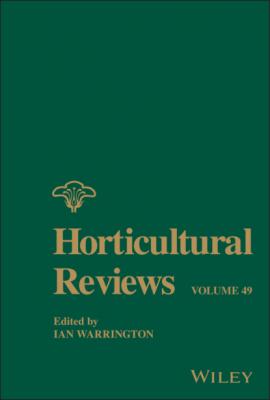Horticultural Reviews, Volume 49. Группа авторов
Читать онлайн.| Название | Horticultural Reviews, Volume 49 |
|---|---|
| Автор произведения | Группа авторов |
| Жанр | Биология |
| Серия | |
| Издательство | Биология |
| Год выпуска | 0 |
| isbn | 9781119851974 |
5 MORPHOLOGY OF OAKLEAF HYDRANGEA
6 BIOTIC AND ABIOTIC CONSIDERATIONS
7 GENETICS AND BREEDING Ploidy and Genome Size Pollination Biology Breeding for Disease Tolerance/Resistance Breeding for Compactness Breeding for Cold Hardiness Breeding for Floral Characteristics Germplasm Resources Molecular Resources for Breeding Genetic Variation in Hydrangea
I. INTRODUCTION
Hydrangeas have been important plants throughout history, with records of their use going back as far as ancient China (Mallet et al. 1992). Hydrangeas have had cultural impacts through use for medicine and ornamental horticulture. Various species have traditionally been used medicinally throughout East Asia (Long and Li 2004; Abe and Ohtani 2013; Singh 2016) and in southeast North America (Banks 1953; Cozzo 2004) for a variety of purposes, including treating abdominal pain, colds, fevers, and arthritis.
In addition to being popular florist crops, plants in the genus Hydrangea are flowering shrubs that have been increasing in popularity in recent years as versatile and attractive landscape plants. This increase can in part be attributed to the introduction of remontant H. macrophylla Thunb. cultivars, notably, ‘Bailmer’ (Endless Summer® The Original) in 2004. Since then, other Hydrangea species have also experienced an increase in popularity. Although H. macrophylla has been well studied, other Hydrangea species have not received as much attention. H. quercifolia Bartr. (oakleaf hydrangea), in particular, has been little studied even though it is such a unique species.
Although it has not been utilized to the same extent as H. macrophylla, oakleaf hydrangea offers great potential to make a major contribution to any landscape. The attention currently being received by the genus due to the discovery and improvement of reblooming H. macrophylla can be capitalized on as gardeners begin to look for diversity in the genus. H. quercifolia is distinguished among hydrangeas by its lobed leaves, attractive exfoliating bark, and potential for intense fall colors (Figure 1.1). This combination of traits allows oakleaf hydrangea to add four‐season interest to the landscape, unlike any other Hydrangea species.
Figure 1.1 Unique aspects of oakleaf hydrangea. Lobed leaves, showy panicles, intense fall foliage color, and exfoliating bark.
(Source: Photo credits: A. Sherwood.)
II. HISTORY AND TAXONOMY OF HYDRANGEA
Hydrangeas have been cultivated for centuries in Asia, with several clonal varieties (such as ‘Rosea’ and ‘Sir Joseph Banks’) having been selected prior to exportation to Europe and then being renamed (Church 2001). Hydrangea arborescens L. was exported to Europe in 1736 by John Bartram, making it the first Hydrangea species to be cultivated on that continent, this occurring before the genus was even named. The name Hydrangea was first used by Johann F. Gronovius to describe H. arborescens in Flora Virginica (Gronovius 1739) and was later used by Linnaeus for the same species in Species Plantarum (Linnaeus 1753). However, previous to the establishment of the Hydrangea genus, the first plants which are now known as Hydrangea were described by Engelbert Kaempfer as Sambucus (Church 2001). In 1784, Carl Peter Thunburg described what are now known as H. macrophylla ssp. macrophylla and H. macrophylla ssp. serrata as Viburnum macrophyllum and V. serratum, respectively, in his Flora Japonica (Thunberg 1784); Sir Joseph Banks then introduced these species into Europe for the first time in 1789 (McClintock 1957). Ruiz and Pavón first described the South American Hydrangeas in 1789, placing them in the genus Cornidia (Ruiz and Pavón 1789). Hydrangea quercifolia was first described by William Bartram in 1791; this is discussed below in further detail. Later, in 1859, Philipp Franz von Siebold first described H. paniculata Sieb. and several other Asian Hydrangea species (Mallet et al. 1992).
A monograph for the genus was written by McClintock (1957), which divided Hydrangea into 23 species. Although this study was based entirely on herbarium voucher specimens, it has been the authority on Hydrangea taxonomy until recently, as evidence has been building for an updated classification. The plants in this genus are woody shrubs, lianas, or small trees, and either semi‐evergreen or deciduous. The inflorescences of Hydrangea species consist of many inconspicuous perfect florets surrounded by few to many conspicuous florets; the conspicuous florets typically contain four large petaloid sepals and have reduced fertility. Hydrangea flowers are mostly corymbs, with two notable exceptions; H. quercifolia and H. paniculata, which are the only Hydrangea species to have inflorescences in the form of panicles.
Although historically Hydrangea was placed in the Saxifragaceae, newer genetic evidence (Morgan and Soltis 1993) supports Hydrangeaceae as its own family in the order Cornales. The Hydrangeaceae family consists of about 270 species within about 17 genera (De Smet et al. 2015). The family is divided into two subfamilies, Jamesioideae and Hydrangeoideae (Hufford et al. 2001). Subfamily Hydrangeoideae contains two tribes, Philadelpheae and Hydrangeeae (Soltis et al. 1995). Hydrangeeae contains nine genera and is further broken into two clades (or subtribes), named Hydrangea I and Hydrangea II (Samain et al. 2010). Other genera in Hydrangeeae are Deinanthe, Cardiandra, Schizophragma, Pileostegia, Decumaria, and Platycrater (Hydrangea I), and Dichroa and Broussaisia (Hydrangea II).
A recent phylogenetic analysis based on chloroplast markers (De Smet et al. 2015) has considerably altered the structure of the genus Hydrangea by including all species in the tribe Hydrangeeae into the genus Hydrangea and reworking the old generic names into sections (Figure 1.2). This taxonomic treatment is consistent with several previous studies and is well supported by molecular and morphological data (Soltis et al. 1995; Hufford et al. 2001; Samain et al. 2010). This new classification places H. arborescens, the type species, in its own section. Although it is most closely related to H. arborescens, due to inconclusive analyses, H. quercifolia was not placed into a section. Further research is necessary in order to accurately resolve the taxonomy of the North
